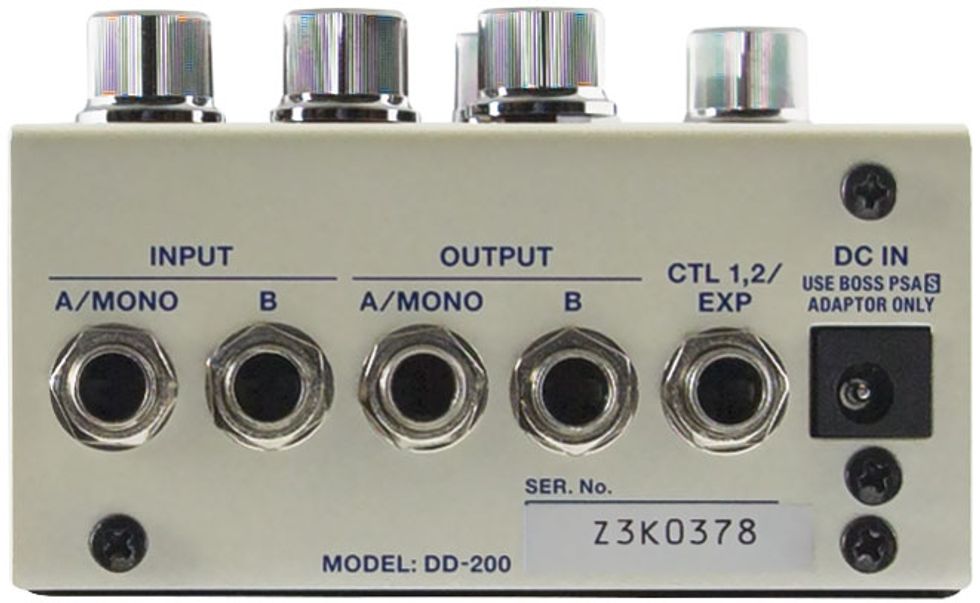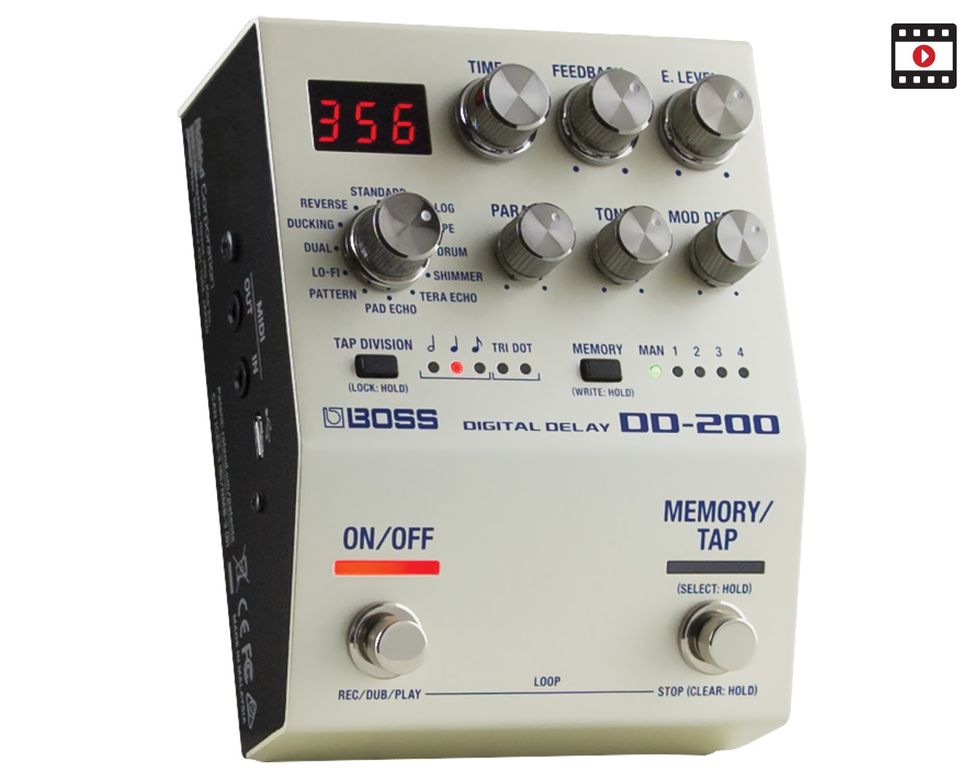RatingsPros:Highly tailorable voices. Easy preset management. External tap option. Cons: Looping can be complicated. Street: $249 Boss DD-200 Digital Delay boss.info | Tones: Ease of Use: Build/Design: Value: |
If you want to chart the strange evolution of guitar effects, delay makes a great case study—not least because so many modern delays go to great lengths to emulate the electro-mechanical quirks of the oldest ones. This urge—to build echoes that span the most archaic sounds and the most inventive modern tones—led to some pretty beastly pedals, some of which have footprints not much smaller than an original tube Echoplex.
But Boss’s DD-200 is one of a new breed of delays that marry the preset and memory functionality, vintage-to-modern voices, and deep parameter manipulation capabilities of larger digital units to a compact-pedal-design ethos. The results are a surprisingly practical and easy-to-use delay with copious tone-shaping options in an enclosure that’s little more than 50 percent bigger than a standard Boss pedal.
Soundly Stuffed
Boss’s DD-200 is a clear descendent of the company’s DD-500 delay—a larger delay that dedicated much of its expanse to footswitches that scroll through preset banks. The DD-200’s smaller enclosure means forgoing the ability to scroll through presets quite so easily. It also means many fewer presets. But it’s still stuffed with an abundance of the 500’s echo-sculpting capabilities and practical preset options—all of which can be accessed with relative ease.
The DD-200 offers a dozen basic voices, from run-of-the-mill digital and analog-inspired sounds to more out-there sounds like Boss’s Tera Echo, pad echo, and reverse modes. But each of these echo types can be modified significantly with the parameter knob, which adjusts factors like the number of virtual playback heads in drum mode, the attack in pad and digital modes, and the amount of distortion in lo-fi mode. A dedicated modulation depth control means you can add a touch of wobble to any of the voices. It also means that none of the parameter modes have to be dedicated to modulation, as they commonly are, opening up more tone options for each voice. The high-boost/cut tone control is also useful for recasting basic delay voices.
The tap division mode button provides half-, quarter-, and eighth-note modes, and dotted and triplet settings for each. And while the DD-200 has just four memory presets (which I’d venture will be enough for most players), they are super-easy to store and recall. Each of these two functions, by the way, can be locked with a press-and-hold function, which prevents errant, mid-song switching.
The effect level and feedback knobs perform as you’d expect. The time control, however, is a click knob that enables precision settings down to the millisecond (up to three seconds) or in beats per minute. There is a drawback to all this micro-precision: Scrolling through all the possible times from minimum to maximum can seem to take a lifetime. On the other hand, presets can be sculpted with exactitude to suit a specific song.
The DD-200 has a 60-second looper, but it’s the trickiest function among an otherwise easy-to-operate set. That’s not to say it’s wildly complicated, but mastering it takes practice. Simply activating the looper requires hitting the bypass and tap tempo switches simultaneously. Thankfully, the DD-200 is pretty forgiving at perceiving your intent if you don’t land a perfectly simultaneous switch. But, once you do that, you have to be careful about the one-click/two-click/hold process by which you start and stop recording and activate overdubs. The DD-200 isn’t the only delay/looper that uses such sequences to extract maximum looping capability from the fewest switches, but it can be challenging in the learning stage and tricky to use onstage if you haven’t mastered the process.
Echo Spectrum
There are a lot of useful echo options among the DD-200’s delay voices. The analog voices offer convincing if not super-dimensional approximations of their respective inspirations via darkening repeats. And the Echorec-style drum delay setting offers cool polyrhythmic options that can be shaped with relative precision.

The less classic voices are fun, too. Tera Echo adds percolating tracer effects to echoes. Pad echo creates sustained echoes, albeit with a digital-ish long-reverb flavor that recalls many ambient reverb pedals. Pattern echo enables selection of several staccato repeat patterns that, while tricky to use rhythmically through a whole song, are cool for song intros or for punctuating a solo. The reverse delay enables useful attack adjustments through the parameter knob as well as the ability to remove the dry signal entirely, which means you can replicate real studio reverse tape effects—a capacity seen in few affordable reverse delays.
Some voices are less successful. The distortion that distinguishes the lo-fi delay sometimes sounds less than perfectly dovetailed with the overall tone. The ducking delays can feel awkwardly grafted to the dry signal at all but the lowest sensitivity and mix levels, and the shimmer delay comes with sonic baggage that comes with any shimmer delay or reverb. (Let’s say it’s an acquired taste.) Each of these settings can be re-shaped enough with the capable control set to work at subtler levels, and the appeal of each is down to personal taste and application. And if there’s one really beautiful, over-arching benefit to the DD-200’s design, it’s that any of these voices can be bent to suit the expression coming from your hands and guitar just as easily as it can guide you in creative, uncharted waters.
The Verdict
The Boss DD-200 is a pleasure to use. It constructively carves out a useful middle ground where ease and utility meet the expressive potential of wildly varied presets and extroverted and heavy delay textures. It invites experimentation, but just as readily delivers familiar, easy-to-navigate classic voices. And at $249 it is fairly priced for a unit that strikes a smart compromise between the space it occupies on a board and the many ways it can get truly spaced out.
Watch the First Look:








![Rig Rundown: Russian Circles’ Mike Sullivan [2025]](https://www.premierguitar.com/media-library/youtube.jpg?id=62303631&width=1245&height=700&quality=70&coordinates=0%2C0%2C0%2C0)

















